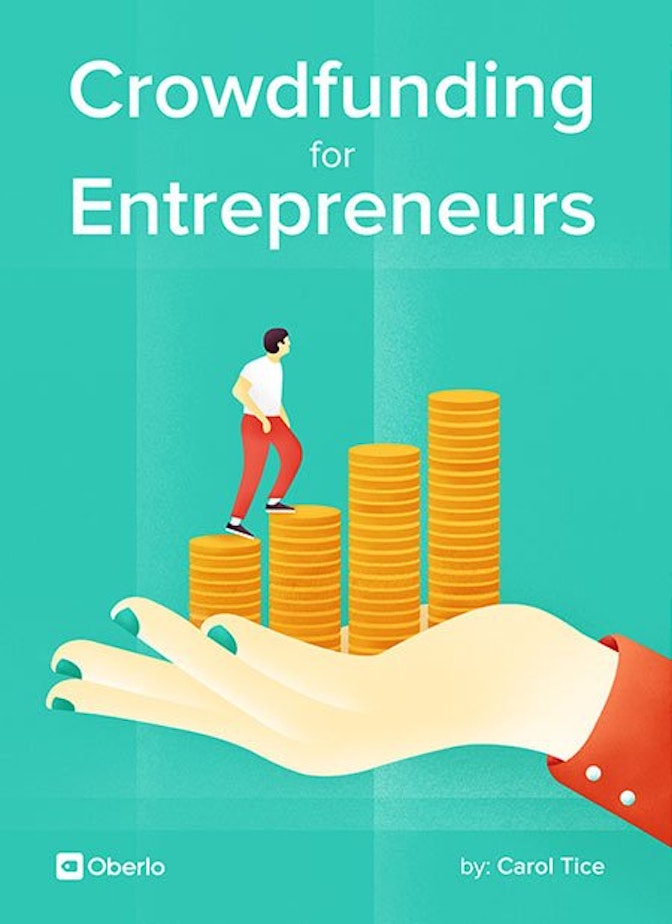Hopefully, you’ve gotten inspired by all those crowdfunding examples. You’ve considered when to launch a crowdfunding campaign, and decided your time is now.
If you’re wondering how to start a crowdfunding campaign, here’s an easy, step-by-step action plan to help you build your own crowdfunding campaign strategy.



A. Define Your Campaign
First, let’s answer the key questions that shape all successful crowdfunding campaigns:
- What are you going to raise money for?
- Where will you raise it?
The answers to these two questions are related.
For instance, if you want to raise funds for growth, equity crowdfunding or crowdlending are your options. Rewards-based crowdfunding requires a concrete, specific project or product.
→ Click Here to Launch Your Online Business with Shopify
Once you know the category you’ll use, it’s time to compare platforms and choose one for your campaign. You can use the platforms list in Chapter 2 as a guide.
Apply to your chosen platform and see if you can get accepted. Especially in equity, platforms are highly selective and reject many applicants. Be sure to have a backup plan with additional platforms to try.
Two more key questions:
- What is the purpose of your crowdfunding campaign?
- How will you structure it?
Again, these two questions are linked.
[highlight]While most of the best crowdfunding campaigns are done to raise money, some are more about market research, as we saw with Nomad Energy. The purpose of your crowdfunding campaign will shape whether you want to do an ‘all or nothing’ or ‘keep what you raise’ campaign.[/highlight]
If you’re manufacturing something, you may need to hit a funding level to be able to make your widget. In that case, ‘all or nothing’ is a must.

Michael J. Epstein, Crowdfunding Investor
“The idea is to say, ‘This is something that won’t be made without your help,’” says author Michael J. Epstein. “When people do flexible Indiegogo campaigns, it says, ‘We don’t really need this money, we’ll do it regardless.’
“I worry it sends the wrong message, and possibly changes the amount a person wants to commit to your campaign.”
In other words, ‘all or nothing’ crowdfunding campaigns create urgency for backers. They know you need their money to put their campaign over the top and get your thing made.
How much will you raise?
The answer to this question often determines the success of your crowdfunding campaign. Setting too low of a goal may leave you without enough cash for your business’s needs, but setting it too high may make your crowdfunding campaign fail.
In equity, you’ll often be setting a fundraising range, say $50,000–$250,000. Making your bottom figure means you keep the money.
Big tip: Study the statistics on successful crowdfunding campaigns on your target platform and the average amount they raised. If everyone on the platform is setting a $1 goal so they can easily overachieve and look buzz-worthy, you’d do well to follow the crowd.
Who is your audience?
You may already partly know the answer to this question, if you’re not on your first product or service. But remember that your existing audience might be different from the audience that wants to back your thing in a crowdfunding campaign.
Now’s a great time to do market research, particularly of past successful campaigns in your space. See who backed them and why. Read the campaign comments to get a sense of audience concerns. This will help you plan your crowdfunding campaign strategy.
What is the budget for your crowdfunding campaign?
How much can your startup spend in order to attract this online money? This figure will shape your crowdfunding marketing plan.
For instance, will you need to rely on your team’s muscle and free marketing methods such as email? If you can afford to spend for advertising or hire pro outside help on your campaign, you have more options.
What is your target launch date?
You’ve learned about the need for a pre-planning phase of 6 months or more. With equity campaigns, you can’t market beforehand, but you’ll need to do much legal and other prep work behind the scenes to make your launch go well.
Consider how ready your audience is for your offer, or how much new work is needed to build more interest. Then, figure out your best potential launch date. Startups with successful crowdfunding campaigns usually aren’t rushed to market—the founders wait for their ideal moment.
B. Get to Know Your Crowdfunding Platform
Once you’re accepted to a fundraising platform, it’s time to learn the specifics of how to win on that particular site. Running a winning Kickstarter campaign is very different from getting equity investors on First Democracy VC, or a loan on Funding Circle.
Many top platforms offer their own how-to guides that distill the lessons from their best crowdfunding campaigns (see Crowd Supply’s in-depth guide here as an example). Study and follow your guide!
[highlight]Don’t work in a vacuum, either. Follow the example of Canadian startup Hardbacon, and reach out to platform managers with questions and requests for feedback. If managers know your campaign, they’re more likely to feature or recommend it, which could help you raise more.[/highlight]
Some platforms even give you a coach or mentor from their staff. Search every corner of the platform, and take advantage of all the free resources your platform offers.
Consider Using Platform-Based Services
Most big platforms offer a range of page design, marketing, video production, legal paperwork, shipping, and other services to help your campaign succeed. Sometimes you’ll be offered free services, whereas others charge you for various types of help.
Consider your team’s weak points, time constraints, and whether using platform services—or your platform’s recommended partners—would be a good move. Many of the best crowdfunding campaigns make use of third-party help.
C. Create Your Crowdfunding Marketing Plan
This section might be better titled, Create Your Battle Plan. You’ll be fighting a war for backers’ attention in an era of record-short attention spans. How will you be victorious?
Begin by assembling your ‘army’ of people, methods, and weapons (a/k/a tools) that you can use in your quest for success.
Choose Your Crowdfunding Marketing Methods
How to market your crowdfunding campaign? Begin by deciding what forms of marketing you plan to use—and finding a team member who will be the point person for executing each method. Marketing methods might include:
- Email marketing to your existing audience
- Content marketing (your own blog posts, guest posting, white papers, etc.)
- Social media marketing
- SMS or text marketing
- Live events
- ‘Street teams’ of rabid fans
- Public relations/outreach to traditional media
- Influencer outreach to online personalities and bloggers
- Early product reviews
- Advertising (online, in print)
Some forms of effective crowdfunding marketing, such as getting early product reviews, will need to happen well before your campaign launches. Other marketing tasks will happen during the campaign.
Assemble Your Crowdfunding Marketing Assets
Next, gather the marketing assets you have at your disposal. What will get backers excited? Think of these as the weapons your army will use in your marketing battle.
Some of the marketing assets often used by successful crowdfunding campaigns include:
- Company website, opt-in pages
- Awards or other industry recognition
- Early reviews
- Previous press mentions
- Press releases
- Demo videos
- Partnerships with influencers
- Team bios
- Case studies of happy customers
- Speeches or interviews
Listing your startup’s existing marketing assets will give you a chance to see what might be missing from your arsenal that you’d like to create before you launch.
This will also give you a chance to assess whether your launch date is realistic, or whether you might need more time to create key marketing assets and shape your crowdfunding campaign strategy.
Mix and Match
Now, start matching the assets you have to the forms of marketing you plan to do. Will you email your list with a link to your new product demo? Send out a press release about the award you won? Do a Facebook ad that promotes your free case study, which ends with a link to the campaign page?
The possibilities are endless—but you’ll only have so much time. For best results, prioritize your strongest marketing assets, and pair them with the types of marketing you’ve had the most success with in the past.
Make a Marketing Map
Create a schedule of due dates, activities, and assigned team members, to make sure everything gets done. Then, you can put all the tasks in order and prioritize pre-launch items to happen sooner. Here’s a little example:

Consider using a task-tracking program such as Asana to make sure everyone understands what their responsibilities are and when things need to get done.
Consider your overall marketing approach. As you saw in the Crowdfunding Examples chapter, some startups—such as Sweat Cosmetics—saw success pitching to investors directly with Facebook ads. Working their ‘invest in a woman-owned business’ angle paid off.
Others, such as Hardbacon, saw more success just sending people to view funny videos or campaign updates, rather than overtly asking them to invest. Figure out how hard-sell you can be with your audience, or whether a lighter touch might do better.
What’s Your Angle?
Every marketing campaign needs a slogan—a one-line, short summary that explains what you’ve got. For instance, here are a few actual marketing taglines from recent successful crowdfunding campaigns:
- The first wholly new combustion engine in 85 years (LiquidPiston)
- Creating one-of-a-kind plush replicas of people’s pets (Cuddle Clones)
- Next-generation, 3D-printed artificial limbs (Unlimited Tomorrow)
- The world’s fastest tripod (Lumapod)
- The first commercial wi-fi in space (Solstar Space Co.)

What are you offering, and what makes it unique? Remember, you’ll compete against many other current campaigns. Think about how to stand out.
The more concisely you can explain what you’ve got—and the more exciting and groundbreaking you can make it sound—the more easily you’ll attract backers.
Expect the Unexpected
Your marketing campaign should also have backup plans that cover what-if scenarios. Consider all the situations you could encounter during your live campaign. How will your marketing plan need to change if:
- Your campaign struggles to get early backers?
- You quickly meet your target and can unlock extra rewards?
- You decide to cap your campaign, to avoid giving away too much at-cost product?
- You decide to move to another platform, such as Indiegogo, to continue fundraising?
Remember to map out marketing activities for every day the campaign is live. Our crowdfunding examples showed that a blitz of fresh news and updates is key to keeping your campaign moving forward.
The final segment of your marketing plan should cover post-campaign communication with backers, your audience, and the general public. Keep riding the buzz, and make sure you give investors a positive experience.
D. Create Your Crowdfunding Campaign Page
With your marketing plan firming up, it’s time to begin building your campaign page. This is where you’ll implement the crowdfunding campaign strategy you’ve developed to appeal to your target audience.
The good news: You don’t need to put everything you have on you campaign page all at once! In fact, it’s better to add new elements throughout the live campaign. That gives you great, non-salesy announcements you can make to drive more eyeballs to your page.
Let’s talk about all the elements of a great campaign page:
Messaging
In the marketing section above, we talked about the need to quickly explain why your project or company is noteworthy and deserves financial support—in other words, your elevator pitch.
Don’t have an offer that’s super-amazing? That means your copy needs to be even better.
For instance, say you’re just selling a set of throw pillows. The only angle is, the pillows look like classic computers and early smartphones.
Here’s a look at the copy startup Throwboy used in their recent Kickstarter campaign to sell over $78,000 worth of their Iconic Pillow Collection. (If you’re wondering how to build a Kickstarter campaign and how to make a Kickstarter campaign successful, this one makes a textbook case.)

You’ve gotta love how they take “buy a cute pillow” and turn it into “own a piece of tech history.” Sell it, baby!
Rewards
This is one of the key steps that makes rewards-based campaigns succeed or fail. What can you entice your backers with?
Brainstorm a list of everything that might delight your particular audience. We’ve heard in previous chapters about offering movie-credit space, behind-the-scenes crowdfunding videos, newsletters, factory and farm tours, and more.
It’s key to offer rewards from lower price points to high. At least six or eight reward levels is pretty standard, and many startups are doing more.
Don’t forget socially shareable rewards that offer bragging rights, such as a thank-you note from (or selfie with) the founder.
As Nomad Energy’s Max Steiler related in our Crowdfunding Examples chapter, you may just have someone who wants to buy an $1,800 deluxe rewards package from you. And top-level rewards help the fundraising numbers add up fast.
Don’t forget to have some ‘stretch goal’ rewards in reserve, in case you earn big. Iconic Pillow unlocked these two adorable, low-priced bonus pillows late in their campaign:
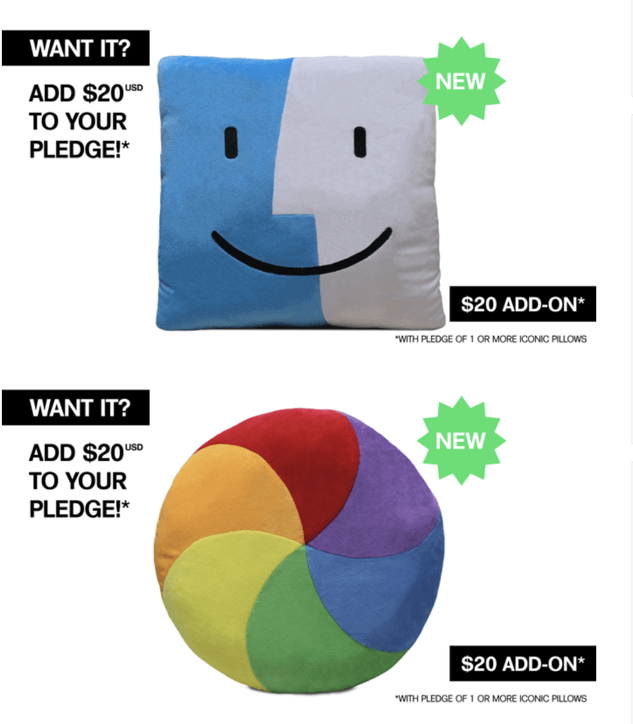
Crowdfunding Video
Increasingly critical to successful campaigns, crowdfunding videos at this point are usually the most important thing to spend on for a crowdfunding campaign. Even tiny, one-person startups are routinely putting together terrific videos—and they’re your competition.
What makes a good crowdfunding video?
For instance, look at how enchanting this crowdfunding video is for craft-maker Natasha Dzurny’s the Ultimate Unicorn Tech-Craft Kit, which easily topped its $10,000 goal:
GIFs and Photos
If you don’t have a big budget for a video with the production value of a feature-film trailer, fear not. Still photos and quick GIFs can also help make your page ‘sticky’ and keep visitors engaged.
For instance, look at how this short GIF makes one of the Iconic Pillow Collection items seem more interesting.

Team Bios
Who’s behind this thing, anyway? Don’t leave it a mystery.
People love to hear the personal stories and passion of each team member for what they’re doing at your startup. Be human and let backers relate to your story.
For instance, look at this great, concise bio on the co-founders who raised $9.4 million on Indiegogo for their folding electric bike, the MATE-X:
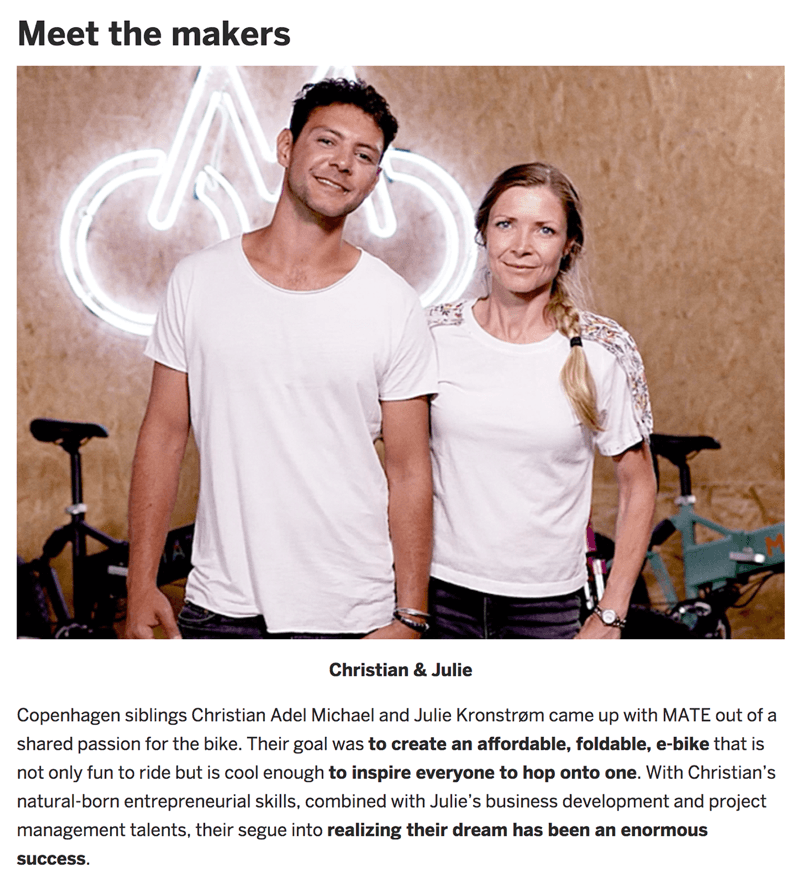
Social Proof
Use any proof you can that you’re getting acclaim and have media mentions, or that influential people think you’re cool.
Whether it’s a screenshot of a tweet from a big influencer, or creating a logo ‘proof bar’ of media where you’re mentioned, social proof converts visitors into investors.
Here’s Iconic Pillow’s eye-catching proof bar:
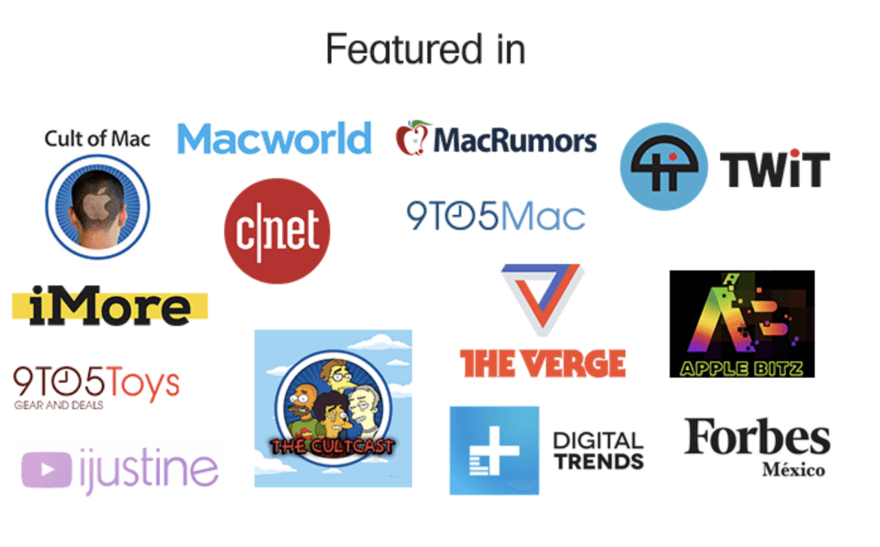
Testimonials
Got an influential person (or five) who thinks your thing is great—or maybe even has already invested in your product? Get a headshot of them and put their quote right into your page, as LiquidPiston did here:
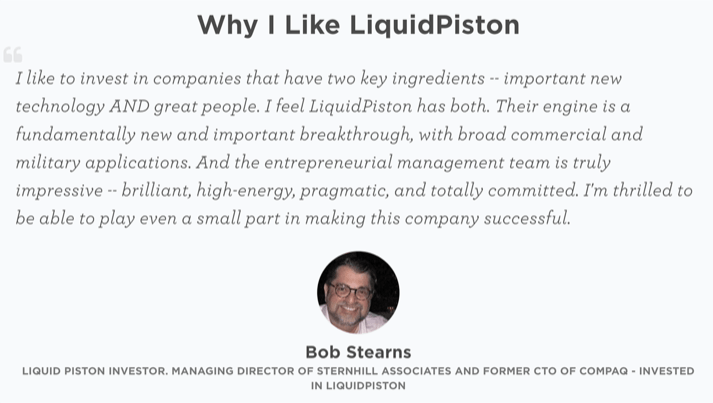
Technical Specs
What’s your thing made out of? Is it bigger than a breadbox? Does it have a USB port? Provide all the technical details. Remember that techno-dorks love to back successful crowdfunding campaigns, and give them the granular details they want.
For instance, MATE-X includes over a dozen different technical thumbnails on its page, like this one:
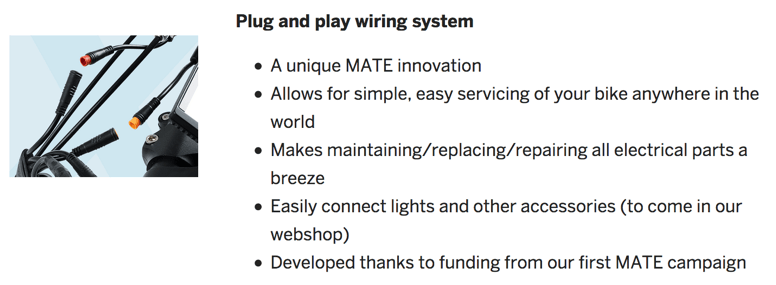
Manufacturing/Delivery Info
The more details you can provide describing how and where your product will be made, and when it will be shipped and delivered, the more it reassures investors they won’t get snookered.
Pre-Launch Page Draft
Remember, with many platforms, you can create a pre-launch version of your campaign page and send it around to your audience for feedback. If you’ve got that option, be sure to do it—you’ll get great ideas for improving your page.
E. Running Your Successful, Live Campaign
It’s finally here—you’ve launched!
Once your campaign is rolling, you should be executing your marketing plan like mad. Try to have something fresh going out each day. Hopefully, it’ll be updates on how much you’ve raised.
The watchword here is ‘responsive.’ Answer questions and comments on your campaign page, in social media, on email—wherever they’re coming from.
Here’s game-maker Jamey Stegmeier providing some great customer service, answering one of the over 22,000 comments his Scythe game got during its $1.8 million Kickstarter campaign:
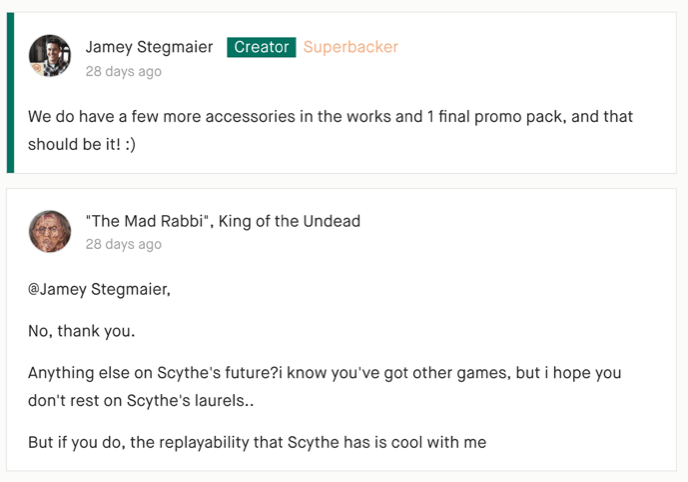
If you can get a media mention to drop during your campaign, that’s basically the PR jackpot. To snag it, offer an exclusive story to your top-choice media outlet, advises author Michael J. Epstein. (See the Crowdfunding Examples chapter for stories on multiple startups that made it happen.)
Try to set it up ahead of time so the reporter can seem smart by putting out a story as soon as you meet your goal. Promise to feature it on your campaign page and promote it to your audience.
Be sure to add new elements to your page as your campaign progresses, to keep the excitement building. For instance, take a look at how long and detailed spinning gyro-top LIMBO’s page was by the end of their wildly successful Kickstarter campaign.
Also, notice how it hits all the key points of a great campaign page—including team bios, mechanical details, awards, varying reward levels, product features, press mentions, multiple short videos, shipping timeline, and more.

How to Get Your Crowdfunding Campaign Noticed
Remember, the early excitement in a crowdfunding campaign comes from the audience you bring, not random people who find your campaign because they’re browsing Kickstarter or another website.
Line up all the success elements you can, such as:
- Building a big audience to promote to
- Big funding on day one from your pre-committed customers/fan base
- Getting influencer mentions or reviews
- Early investment from prominent people
- Social media sharing
- Press write-ups
The more of these elements you can pull together, the more likely your campaign will build buzz and go viral.
If you’ve wondered what makes a good crowdfunding campaign, it’s the combination of as many of these elements as possible. And the more unique your offer is, the easier it’ll be to get those ducks lined up and make this happen.
F. After Your Crowdfunding Campaign Ends – Fulfillment and More
Congratulations—you’ve raised money online! It’s time to contact your platform and arrange for the release of your money.
In other words, it’s time to deliver on your promises to backers.
Hopefully, you planned and priced your product well, and have manufacturing and shipping methods all lined up, if that’s relevant.
Keep communicating with backers! Share a short video from the factory, or otherwise keep them updated on your progress in delivering their rewards.
Send screenshots out on social media. Answer questions. Above all, don’t disappear.



A Note on Crowdfunding and Taxes
You may be wondering whether raising money online means you’re going to owe a big tax bill. Good news: generally, the answer is no (though your situation may vary, depending on where you live).
Here’s a broad overview of the tax implications:
In rewards-based crowdfunding, your income may be taxable, as Kickstarter notes—but you can deduct all your costs first. Since most rewards campaigns sell goods roughly at cost, and the campaign costs are also deductible, you shouldn’t owe much.
If you do equity crowdfunding for an ownership stake in your startup, that’s considered an investment, rather than taxable income. The tax issues fall on the investors, more than on the startup.
In crowdlending, you’ve borrowed money, rather than received funds that are yours to keep. You may be able to claim your interest payments as a business expense.
As with any business-tax issue, situations are highly individual. Be sure to consult with your tax pro if you have online fundraising income.

